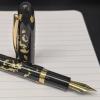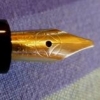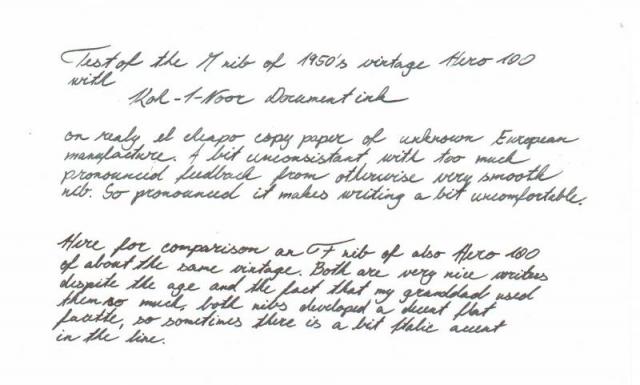Search the Community
Showing results for tags 'resistant'.
-
I work in a regulatory chemistry lab so having basically everything resistant ink is a must for archival & forgery purposes. Where I'm at we're under EPA regulations (vs. ISO or TNI) so it only says indelible ink. The majority of the inks I use are Noodler's bulletproof inks & have been approved by our QA/QC officer. Since Noodler's inks are not ISO or anything else certified I decided to do my own tests with some of our common solvents in the lab in case an auditor ever asks about it. My test wasn't anything super scientific but should be enough to show anyone the permanency of the ink. While I was at it I figured it's nice to share my results with you. The test: I filled a beakers with 6 common solvents we use in our lab. The solvents are Hexane, Acetone, Ethyl Acetate, Methylene Chloride, methyl tert butyl ether(MTBE), and Methanol. I wrote the name of each ink on plain copy paper and let it dry overnight. I then let it soaked each piece of paper in the corresponding solvent for at least 1 minuet. During the soak I agitated the piece of paper several times in an attempt to force the ink to wash off. And for reference I wrote the name of the solvent the paper was placed in with a black Bic pen. After soaking I removed the paper and placed it on the counter to dry. Edit: One other note, the ink labeled Noodler's Teal is a 1:4 mix of Bad Green Gator and Bad Blue Heron respectively. This first picture is of everything before it was soaked in solvent. And please forgive my bad handwriting as I was scribbling the names and wasn't worried about penmanship.
-
I came across this Muji product while I was browsing in my local store the other day: I cannot vouch for what the Japanese or the French words on the product label actually mean, but the Chinese words promise that the notebook is "show-through resistant". For the asking price, I was willing to give it a go and test its marketing claim, even though every set of five notebooks was wrapped in cellophane and I could not inspect or feel the paper therein. This is how the reverse side of the page looked, after I've written quite densely on two-thirds of the front, using a variety of fountain pens and inks (of which the details are shown in the image at the bottom): I then used the same pens and inks to write on the reverse side, so that there is a significant area of overlap in which there is writing on both sides, with the same pen and ink for each four-line panel: in order to see how noticeable or distracting the level of show-through is: My conclusion is that the resistance to show-through and/or bleed-through is less effective than what I think one could reasonably expect, in the face of the product's marketing claim. For the price I suppose these notebooks aren't that bad for use with fountain pens, although I know Muji could do better, because a different notebook (made in Japan) I bought on the same visit proved to be incredibly fountain pen friendly, and very resistant to feathering, show-through and bleed-through. With these made-in-Indonesia notebooks, there is some woolliness observed when writing with certain inks, but no significant feathering. People who don't like the feel of the coating on bright white Clairefontaine paper (such as in the 'Age Bag' notebooks) probably won't like this paper either.
-
Hi All, Since Noodler's Waterproof Burgundy is no longer around, is there any waterproof (or incredibly water-resistant) burgundy ink on the market?? I've got waterproof inks in every major color except burgundy and it's driving me crazy! I'm also dreading the thought of having to mix my own with De Atramentis Document inks. Thanks!
- 27 replies
-
- waterproof
- burgundy
- (and 4 more)
-
Koh-I-Noor Hardtmuth is a famous manufacturer of (not only) writing, scribing and painting "tools" and accountrements of all kinds, with over 200 years of continuous history from former Austro-Hungarian Monarchy to current Czech Republic. Their sortiment is broad enoght to cover whole range from hardcore development engineers through different artists by trade to hobby pencil cartoonists. This company is the original, first succesfull creator of todays most simple and notorious writing instrument-a graphite pencil in a wooden stick. From the brief above is quite clear, that Koh-I-Noor is realy not specialized in inks. They have a basic, but usefull range of comon grade writing and india inks in several colours, but kind of "just by the way", they have in portfolio Koh-I-Noor Document Ink Black I can´t say what is it based, as this is kept secret as far as I know. It is not an iron-gal ink, it is not a graphite ink, no way it is a more stable breed of "coloured writing lotion". Probably it is one of the few formulas which work with chemical interaction with celulose in the paper. The colour is dark grey-black or black-grey with distinctive greenish hue, depending on paper and pen combo. It darkens over period of several minutes to several months into flat black with greenish hue.The more it darkens, the more it is resistant to any kind of wash-out. It is awarded ISO 14145-2 and BS 3484-2. The latter is a British norm for permanent record inks, and as the Brits are quite hardcore (another word would fit here better...) about what to consider "permanent record", it means quite a lot. I´m not sure how much pH neutral it is, but will update if I get the info. The ink is a bit more viscous than most others, but flows very well and have some lubricity. Basic Parker Quink feels like running water with no lubrication in compaison, from my point of view on distant memories-but keep in mind this is nib-affected feeling. The viscosity causes very little feathering, even on most low quality papers, but also makes fine nibs to produce M line on some quality papers due to surface tension effects. But the width of the line is consistant, no blots. Frankly, no blots at all, except some realy poor papers or papers of very fibrous nature with "open" surface (like kitchen towels...). Flows well, on some papers almost too fast for my taste, but still not like eg. Quink. Due to its nature, after about 15-30 seconds, depending on the nib, it tends to develop a bit of "skin" and makes the pen a false starter. If the nib has a "baby bottom" grind, it can be realy troublefull to start it again. From wet nibs on quality paper, it produces a realy deeply saturated line, embedded to rock bottom into the paper. From dry writers, it can be kind of greyish, but this realy does not alter the endurance of the line. There may be some trouble with drying up the nib in some F writers with smalish and/or fine compartmented feeds during prolonged period of fast writing. On most papers, is dry almost instantly (2-3 seconds). I posted some general info about torture tests I subjected this ink to, from 2008 to 2014. The post is in the Inky thoughts section, here: https://www.fountainpennetwork.com/forum/topic/288624-koh-i-noor-document-fountain-pen-inks/page-2?do=findComment&comment=3723625 I must add, that the statement "does not clog the feeds" is OK, but after some testing, I´m sure I wil have to give a good bath to my pens, as the M nib Hero 100 writes dryer now than it should. Well, I used it very sparsely in the last 3 years, albeit it was freshly inked all the time. The abuse this ink can stand is simply unbelievable. The paper vanishes, the ink remains. No matter how do you make the paper to vanish. This says it all. Some people (with degrees in chemistry) claims that this ink is probably the most durable against sun fading ever created, if good, uncoated paper with low filler content is used. Here I will quote myself from the above linked post: Several weeks ago, a clipboard with a day worth of important notes (on poor copy paper, 80g/m2), already a bit soaked in the rain, faceplanted into soaked, liquid clay in a ditch. All was covered to no avail under ochroid mess. So I took it home in a plastic bag, washed the paper gently and recovered every bit of info I had written. This says a lot, when I add the paper was more yellowish-brown-ochroid than white as formerly was... The text was not affected at all. The pens used in the standard review sampler are both Hero 100 of 1950´s vintage, daily writers of my grandfather for some 2 decades, now exclusive daily writers of mine for 8 years. My granddad used them so much that a definitive facette has developed on both nibs, which gives a kind of italic accent to the line, as my writing angle is a bit different to grandpa´s-but close enought to apreciate how smooth gliding writers they are, especialy on vintage paper. The water test-I tried to lay down as rich line as I could, to promote the greenish hue which sometimes apears from this ink on some papers, without any shade of compromising readablitiy of the text. So I wrote about one letter in two seconds the top three lines, the bottom in just slow pace-as writing slow, I write even worse pattern than usualy. The test was performed for about 1 minute under hot running water (like 70°C), then soaking like 5 minutes in a bowl of that hot water and rubbing the bottom line with finger. The paper lost the top layers, is one fluffy spot there, but the text is still there. And by the way-there is no alteration to the text after two years maceration in much more agressive solutions than hot tap water... Generaly, I should apologize for the lack of penmanship screaming out of the paper, I used my pens not as frequently as I was used to in the last 3 years (gap in journaling etc.), no practice either... Also, the sampler was printed with a poor toner cartridge, so the thin grey lines are more nonexistant than anything else, so both samples are freehanded, more in a bit of hurry. The ink is availible in Czech Republic 50 ml plastic bottle for less than 1 EUR to 1,75 EUR equal, depending on greediness of the stationery clerk, or in a nice, simple glass bottle of 30g for 3,5 EUR. On other markets, the price is usualy similarly low, as far as I know. It is one of the cheapest inks I´ve ever seen, but of the most durable and bulletproof you can ever have. There is also a blue version on the market, which is not as much durable and was created, as far as I know-because of demand for "nice blue document ink, not that greyish feculence you sell". But there are traces of fading even after just 1/2 year on direct sunlight, which is nonexistant with the reviewed original black formula.
- 2 replies
-
- koh-i-noor
- document ink
-
(and 5 more)
Tagged with:



desaturated.thumb.gif.5cb70ef1e977aa313d11eea3616aba7d.gif)


